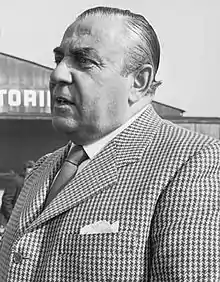Carlo Abarth
Carlo Abarth (15 November 1908 – 24 October 1979), born Karl Albert Abarth, was an automobile designer. Abarth was born in Austria, but later was naturalized as an Italian citizen; and at this time his first name Karl was changed to its Italian equivalent of Carlo Alberto.[1]

Biography
Before World War II
Abarth was born in Vienna, during the time of the Austro-Hungarian Empire. As a teenager, he worked for Castagna in Italy (1925–27), designing motorbike and bicycle chassis.[2] Back in Austria, he worked for Motor Thun and Joseph Opawsky (1927–34), and raced motorbikes,[3] winning his first race on a James Cycle in Salzburg on 29 July 1928.[4] He would be European champion five times, along with continuing his engineering. After a serious accident in Linz he abandoned motorbike racing, and designed a sidecar (1933) with which he managed to beat the Orient Express railway on the 1,300-kilometre (810 mi) stretch from Vienna to Ostend (1934).[5]
He moved permanently to Italy in 1934, where he met Ferdinand Porsche's son-in-law Anton Piëch, and married his secretary.[6] In 1939 Abarth was long hospitalized and had his racing career end, due to a racing accident in Ljubljana, Slovenia.[7] He remained in that country (with some visits to Austria and Italy) until the war was over, where he worked at Ignaz Vok's factory.[8]
After World War II
Following this, he moved to Merano, from where his ancestors originated.[9] Abarth got to know both Tazio Nuvolari and the family-friend Ferry Porsche, and, together with engineer Rudolf Hruska and Piero Dusio, he established the Compagnia Industriale Sportiva Italia (CIS Italia, later becoming Cisitalia), having the Italian Porsche Konstruktionen agency (1943–48). The first automobile outcome of this cooperation was the rather unsuccessful Tipo 360 F1 prototype (see also Porsche 360). The CIS Italia project ended when Dusio moved to Argentina (1949).
Abarth then founded the Abarth & C. company with Cisitalia racing driver Guido Scagliarini in Bologna (31 March 1949),[10] using his astrological sign, the scorpion, as the company logo. The same year, Abarth & Co moved to Turin. Financed by Scagliarini's father Armando Scagliarini, the company made racing cars, and became a major supplier of high-performance exhaust pipes, that still are in production as Abarth. On 20 October 1965 Abarth personally set various speed records at the Autodromo Nazionale Monza.[11]
He sold the company on 31 July 1971 to Fiat, although he continued to manage it as a CEO for a period. Later he moved back to Vienna, Austria, where he died in 1979.
Private life
Carlo Abarth was married three times. His first wife was the secretary of Anton Piëch in Vienna. He married his second wife, Nadina Abarth-Žerjav, in 1949. They lived together in northern Italy until 1966, and divorced in 1979. The same year, about six weeks before his death, Abarth married his third wife, Anneliese Abarth; she continues to head the Carlo Abarth Foundation[12] and wrote one of his biographies in 2010.
References
- "Carlo Abarth". sportingfiatsclub.com. Retrieved 2008-01-26.
- conceptcarz.com (last accessed 6 March 2007)
- Abarth Corse SpA from grandprix.com (last accessed 6 March 2007)
- Carlo Abarth Archived May 3, 2007, at the Wayback Machine from abarth.nl (last accessed 6 March 2007)
- Abarth Historie Archived September 29, 2007, at the Wayback Machine from reinhard-mergel.de (last accessed using Google cache, 6 March 2007)
- Cisitalia Archived February 26, 2008, at the Wayback Machine from usuarios.lycos.es (last accessed 7 March 2007)
- "Spet tisoči pri dirkah". Jutro. Ponedeljska izdaja. November 13, 1939. p. 7. Retrieved April 29, 2019.
- "Abarth History". Abarthisti. Retrieved July 27, 2019.
- Abarth history Archived 2008-02-25 at the Wayback Machine from histomobile.com (last accessed 6 March 2007)
- Abarth ... attenti alle scorpione!!! from lanciarally037.com (last accessed 6 March 2007)
- Behind the Abarth name from italiaspeed.com (last accessed 6 March 2007)
- "Carlo Abarth Foundation".